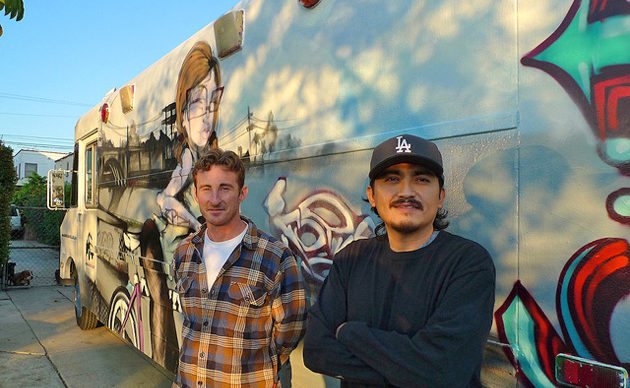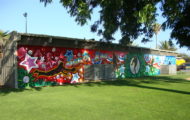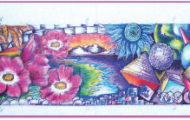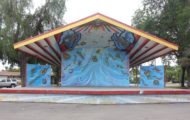Roberto Del Hoya
Roberto Del Hoyo is a South Los Angeles native who graduated from California State University, Los Angeles with a Bachelor’s Degree in Fine Arts, with an emphasis in Studio Art. In 2010, Del Hoyo earned his Master’s Degree in Fine Arts, with an emphasis in Public Practice, from the OTIS College of Art and Design in Los Angeles. In 2012, Del Hoyo met fellow graduate student David Russell, and both collaborated with Judy Barca, Sonya Fe, and other L.A. based artists on the “Great Wall of Los Angeles” restoration project.
Del Hoyo and Russell later formed the artistic project and business Mobile Mural Lab (MML), a response to a Los Angeles city ordinance that declared public murals on private properties illegal. The MML works primarily with school youth in L.A. and Orange County communities to help paint murals and create a positive space for art education and individual expression outside the classroom.
Sources Used:
1. “Mobile Mural Lab,” OTIS College of Art and Design, August 27, 2013.
2. Sonya Fe, “Art on the Run: Roberto Del Hoyo’s Mobile Mural Lab,” KCET, May 22, 2012.
Image Source (Top): Gelatobaby used under a Creative Commons License - -
2010
MLB All Star Game Mural
MLB All Star Game can be seen from the street in front of the parking at James C. Fremont Elementary School in Santa Ana, located specifically on the side of the El Salvador Center building next to the baseball diamonds. Roberto de Hoyo, the mural's artist, used red, green, blue, black, yellow, and white colors to make his four silhouettes of baseball players stand out as the subjects. Incorporating baseball and community iconography, the mural promotes youth sport involvement, team and community building skills, and encourages youth to work towards achieving one's goals through sports.
2011
Santiago Park Mural
The Mural
Former Santa Ana Parks, Recreation, & Community Services Agency Director Gerardo Mouet asked the mural’s artist, Roberto Del Hoyo, to paint a mural that displayed themes of Santiago Park and the Discover Science Center. Del Hoyo painted the center panel in his Los Angeles art studio. Over 100 volunteers from Santa Ana donated their time to help paint the other two wall panels under Del Hoyo's supervision. The mural's dedication ceremony was held on January 15, 2018.
People walking from Santiago Park notice a unique artistic transition in the Santiago Park Mural. In the first half, the mural contains colorful depictions of natural and environmental beauty, including Eucalyptus leaves, water grass, California Poppy flowers, the Santa Ana River, and the San Gabriel Mountains. The other half then follows with countless pictures of cubes, spheres, and other geometric symbols. The mural boasts a plethora of vibrant blues, oranges, reds, greens, and violet colors to emulate natural and scientific beauty, and the very top of the center panel shows a stone bridge connecting nature and science.
Tongva Tribe
At the very bottom of the Santiago Park Mural are river rocks with Tongva Tribe glyphs. Historically, these glyphs appeared on rocks and boulders, representing some kind of Tongva ritual, such as hunting or coming-of-age ceremonies. The first Tongva people settled along the Santiago Creek Watershed during the 1700s. As a hunter-gatherer society, the Tongva gathered a variety of fruits, seeds, hunted small game, and fished to survive.
The Tongva Tribe and other neighboring Natives experienced a culture shock with the arrival of the Spanish in the late 1700s. From about 1769 to 1833, the Spanish built missions and ranchos across Orange and Los Angeles Counties to Christianize and modernize Native tribes - i.e. calling Natives "Gabrielinos." In 1810, the King of Spain granted Jose Antonio Yorba and Juan Pablo Peralta the rights to Rancho Santiago de Santa Ana, which encompassed a large part of present-day Orange County. The Tongva depended upon the missionary system and Rancho Santiago de Santa Ana for survival.
Sources:
1. Art Pedroza, "Over One Hundred Volunteers Show Up to Paint a New Mural at Santiago Park," New Santa Ana, Jan. 15, 2011.
2. Special Thanks to Anthony Novella, the Community Services Supervisor and Naturalist Matilde of the Santa Ana Parks, Recreation and Community Agency.
Memorial Park Mural
In 2011, Los Angeles artist Roberto Del Hoyo painted the large 5-sided pavement art mural located on Memorial Park Stage, which functions as a cultural center where people can enjoy different kinds of entertainment and events such as live music. The stage was erected in 1957 under Mayor Ogden Markel, but the mural itself was not commissioned by the city until 2011. The iconography used in the Memorial Park Mural can be best described as a combination of community, unity, and religious and spiritual imagery. The colors used are consistent with those that make up the American flag, but blue seems to be the dominate color overall, possibly representing peace or harmony within the park's immediate Santa Ana Bristol Manor/Bristol Warner community. Some of the mural's images represent culture, education and unity - musical instruments, a graduation cap, a pencil, etc. The giant hands located at the roof of the stage potentially represent a "higher power," connecting religious thought with the local community. The eagle with the American flag shield at the top between the giant hands could also represent the narrative of American exceptionalism.






